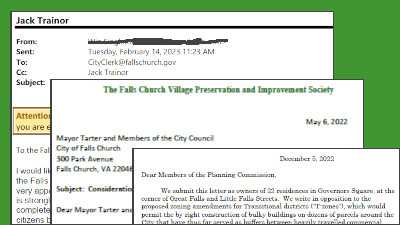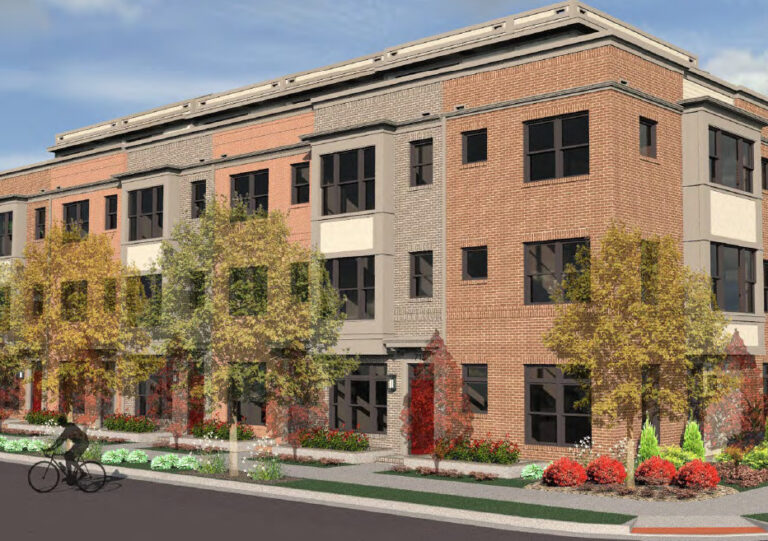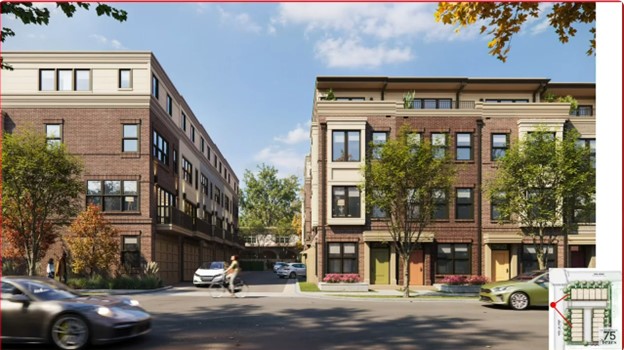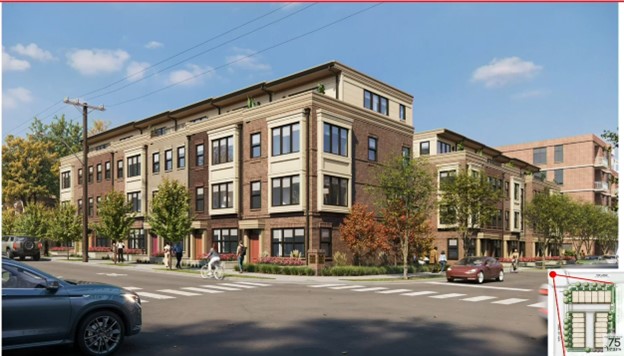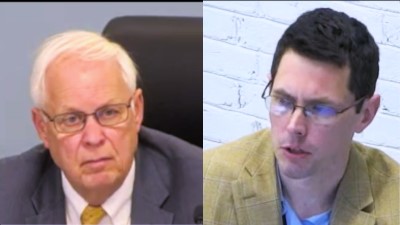Citizens React To T-Zone Proposal (Part I)
A serious issue in Falls Church, and one that motivated the creation of Falls Church Pulse, is the need to inform citizens of proposals that can have a significant impact on the future of this City. The Village Preservation and Improvement Society, VPIS, was the first to ask questions about the City Council’s T-Zone proposal in a letter to its members in the fall of 2022. VPIS has also submitted several letters to the City Council stating their opposition.
“Without a compelling case that the proposed transition zone changes will effectively serve an important public purpose, and that the burdens imposed on existing residents and the environment are proportionate to the public benefits, VPIS opposes the proposed changes.”
Eventually, as word began to spread, City Hall received more letters regarding the proposed new T-Zone ordinance. As of June 2023, there are over 150 letters, 12% in favor of the changes and the rest opposed. They come from individuals, former Planning Commission and City Council members, mayors, and vice mayors, and homeowners associations (HOAs).
“Let’s call a spade a spade. First, City Council’s zoning changes for transitional lots would not improve them. They would eliminate them, effectively converting the T-Zones to commercial zones with near B-1 heights and B-2 density. ….
Fourth, despite the early emphasis on residential housing, the changes also would permit large commercial buildings by-right, with no City review for attractive architecture, neighborhood compatibility, tree canopy, or green space.”
– Mary Chaves, November 2, 2022
“We oppose the T-Zone changes because they represent a radical, negative departure from the current zoning regulations that provide important protections to Falls Church residents across all neighborhoods and housing types. Doubling the size of allowable lot coverage, raising height limits, and reducing required setbacks of neighboring property—as these new regulations do—negatively affect privacy, quiet, and green space. In fact, the narrowing of space between construction and the street or a neighboring property may make it impossible to plant or grow trees in many areas. Will Falls Church still be a recognized ‘Tree City USA’?
These regulations essentially eliminate the transition zone—a 50-foot-tall building on 80% of the lot within 10 feet of its neighbors is hardly transitional—so that there is no longer a buffer between commercial and residential areas. City residents have relied on that buffer for many, many years.”
–Ellen Gross, Former Vice Chair of the Falls Church City School Board; Jane Scully, Former Member of the Falls Church City Council and Chair of the Falls Church City School Board; Sally Phillips, Former Chair of the Falls Church City Planning Commission; Marty Meserve, Former Vice Mayor of the Falls Church City Council, Former Chair of the Falls Church Planning Commission, and Former Chair of the Falls Church Economic Development Authority; Ellen Salsbury, Former Chair of the Falls Church City School Board, November 2, 2022
“Falls Church had the opportunity to stay unique like Del Ray, and now it is turning into Clarendon levels of development activity. I am not in support of these transition zones and want to share that with you as a resident of Falls Church City. This is one additional step towards eroding the charming aspects of our town that brought so many of us here in the first place.
We already have massive structures coming at [Broad and] Washington and at the high school, plus Founders Row, but now to impinge on our neighborhoods more, this will threaten so much more. Traffic on Park and surrounding streets is already a nightmare sometimes, with people blowing by stop signs. I have young kids that are not allowed out front without us due to said traffic and this will be worse. Please reconsider this proposal.”
–Caitlin Yerkes, November 29, 2022
“As a 30-year resident of the City of Falls Church, and always sympathetic to the needs of the City for revenue, I have watched with increasing dismay the sometimes unnecessary selloffs to developers. Case in point, the current T-Zone proposal, that advantages developers over residents of our poor “little city.” May I please add my vote to the Planning Commission members who say that the use of specific T-Zone properties might be better decided on a lot-by-lot basis and not by an across-the-board zoning amendment?”
“One suggestion to the proposed changes is to INCREASE the percentage of affordable housing units and/or workforce housing units to 15%.
As a 30-year resident, homeowner—and business owner—in the City of Falls Church, I support changes that will bring more people to the City as customers for our existing and future businesses and as residents.”
Through neighborhood networks, the most concerned citizens found each other, and an informal group coalesced to discuss how to confront this issue. Many felt Council members were not taking their concerns seriously. Some Council members believed the protesters were in the minority. The group decided the best way to get the City Council’s attention was to demonstrate through a petition the significant opposition to what was being proposed. More than 400 City residents signed the petition.
The group called themselves City Residents Who Support Responsible Development, and each member sought to help his/her neighbors and HOA members keep up to date with the T-Zone discussions. (Some members also are now involved with Falls Church Pulse.) Ahead of the Planning Commission meeting to vote on recommendations to the City Council, the group wrote a letter listing their concerns. It begins:
“The T-Zone initiative began almost two years ago when the City Council asked the Planning Division to propose changes to promote residential infill development. Possible amendments to the zoning ordinance governing transition districts soon became the focus of this effort. For over a year, the Council sought feedback from and engaged in ongoing dialogue with developers but did not engage the public. The City held no information sessions or pop-ups, conducted no surveys or focus groups, and did no outreach to people living in or adjacent to T-Zones. In May 2022, the City Council referred out a proposal that significantly differed from the recommendations of former Arlington planning director and City-hired planning consultant, Susan Bell. The Council proposal disregarded environmental concerns, bore little resemblance to existing code provisions for residential districts—whether cottage, cluster residence, townhouse, single family or multifamily—and invited B-1-level development in T-Zones, for both residential and by-right commercial projects.”
–City Residents Who Support Responsible Development, February 3, 2023
Some of the many letters submitted ahead of that meeting are excerpted below:
“I am unalterably opposed to the current updates to the T-Zones. The City is waiving all sorts of environmental/quality of life protections so that more housing can be built in a town where there are vacancies already and massive developments being raised in three areas. Why don’t we all just live on a parking lot next to I-66? It’s ludicrous at this point. Ludicrous.”
–Andy Ehrlich, February 1, 2023
“Given the confusion surrounding the possible unintended consequences of the ordinance as written, the lack of clarity about the goals the ordinance is seeking to achieve, the concern that one size will not fit all, the importance of addressing the missing middle and affordable housing situation, and the lack of clarity about how the ordinance will affect each of the 50 plus parcels under consideration, the Planning Commission should NOT approve the ordinance but instead recommend that the Council establish a special Task Force to study the issue and make recommendations.
At the very least, given that the revisions the Commission is reviewing were made public a few short days ago, the Planning Commission should defer its recommendation so the public can have an opportunity to review the changes and provide comment.
There is no rush. This is an important issue that can have dramatic impacts. Let’s get it right.”
–Marty Meserve, February 12, 2023, Former Vice Mayor and Planning Commission Chair
“Saint James Catholic School directly abuts properties that would be rezoned under the current T-Zone proposal. T-Zones 11, 12, and 13, which neighbor Saint James, are currently populated by small residential properties that have been converted for commercial use. These are low profile properties that aesthetically match the residential character of the neighborhood and have minimal impact on parking and traffic conditions.
If the T-Zone proposal is approved, these zones will be redeveloped into one or more large-scale development projects that directly impact our community. Previously, our School and Church were snuggly nestled in a residential neighborhood of single family homes. The residential setting provides protection to our students under VA Code § 18.2-370.3, which prevents registered sex offenders from living within 500 feet of a school. A residential setting creates a safe environment for our children to play outside, as well as walk to and from school.
Now, we may be surrounded—on all sides—by large, mixed-use concrete developments targeted at transitory adult constituents—including a hotel, movie theater, and bars.
Having reviewed the T-Zone proposal, we feel strongly that the modifications will negatively impact:
- The safety and well-being of our children in the School’s highly visible outdoor play spaces; and
- Traffic/parking density in and around the School during drop-off, pick-up, and school events.”
–Tiffany Morris Palazzo, February 13, 2023, St. James Catholic School parent
“I am writing to encourage the changes to the transitional zones as proposed by the planning committee. Since I first lived in the city in 1997, followed by my 13 years of being lucky enough to attend Falls Church City Public Schools, the city has been in need of greater affordable housing.
This prior need is compounded by the city’s 2022 Annual Community Profile stating the population will increase from 14,309 to 20,549 (43% increase), the city previously took over 60 years to increase the population by 6,000 people (1950 Census Population: 7,535). This dramatic change requires the city to make changes to ensure that people have safe, affordable, and dignified places to live.
The proposed zoning changes support the city’s vision for the “creation and maintenance of a diverse housing stock to support an inclusive and welcoming community.” Furthermore, the additional tax revenue generated to support designated affordable housing units is a great first step to ensure that Falls Church can be “The Little City” for all.”
–Marek Wojtala, February 15, 2023
“There certainly is no “rush” to get this done since the number of land parcels affected in our city are so few. Furthermore, one of the premises in the Power Point presentation is regarding promoting diversity and price for residential spaces. It was very clear from the audience comments and questions that this would not be accomplished this way. As a current Associate Real Estate Broker as well, that is my professional opinion, too. These zoning changes instead would only favor developers who might be “salivating” at the idea of building on virtually every square inch of our land that is left here to make a quick profit and then move on… but it would be accomplished at the expense of current residents and their properties who may very well be negatively impacted by these proposed changes. Sorry to say this, but there seems to be little empathy in our city government for our already existing neighbors and what impact these decisions might have on them that could affect their lives.”

